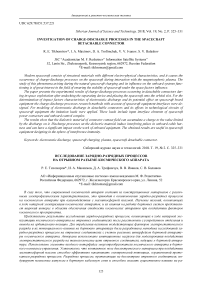Investigation of charge-discharge processes in the spacecraft detachable connector
Автор: Tikhomirov R.E., Maximov I.A., Trofimchuk D.A., Ivanov V.V., Balashov S.V.
Журнал: Сибирский аэрокосмический журнал @vestnik-sibsau
Рубрика: Авиационная и ракетно-космическая техника
Статья в выпуске: 2 т.19, 2018 года.
Бесплатный доступ
Modern spacecraft consists of structural materials with different electro-physical characteristics, and it causes the occurrence of charge-discharge processes on the spacecraft during interaction with the magnetospheric plasma. The study of this phenomena arising during the natural spacecraft charging and its influence on the onboard systems func- tioning is of great interest in the field of ensuring the stability of spacecraft under the space factors influence. The paper presents the experimental results of charge-discharge processes occurring in detachable connectors dur- ing in-space exploitation after undocking the separating device and placing the spacecraft onto the orbital slot. For the determination of impact factors characteristics of electrostatic discharge and its potential effect on spacecraft board equipment the charge-discharge processes research methods with account of spacecraft equipment interfaces were de- signed. For modeling of electrostatic discharge in detachable connectors and its effects in technological circuits of spacecraft equipment the imitation loads were applied. These loads include input interface elements of spacecraft power convectors and onboard control complex. The results show that the dielectric material of connector contact field can accumulate a charge to the value limited by the discharge on it. Discharge processes on the dielectric material induce interfering pulses in onboard cable har- ness and can have a significant impact on the work of onboard equipment. The obtained results are useful in spacecraft equipment designing in the sphere of interference immunity.
Plasma, electrostatic discharge, spacecraft detachable connector, spacecraft charging
Короткий адрес: https://sciup.org/148321844
IDR: 148321844 | УДК: 629.78.051:537.221 | DOI: 10.31772/2587-6066-2018-19-2-325-331
Текст научной статьи Investigation of charge-discharge processes in the spacecraft detachable connector
Introduction. During the interaction of a spacecraft with the magnetosperic plasma operating on the final orbit many physical phenomena occur which particular characteristics depend on both plasma parameters and the spacecraft performance. First of all they depend on electrophysical properties of materials on the spacecraft surface as well as on its configuration. The discharge [1–4] on the spacecraft surface is able to exert the most significant influence on its operation. This process is due to the spacecraft charging [5; 6].
During the final orbit insertion after undocking the separating device contact surfaces of the detachable connectors (ОСМРС50Э, ОСМ РС50АЭ plugs) remain non-shielded and are exposed to the magnetosperic plasma with the following characteristics (in the worst case) [7]:
– electron density is 1.12 cm–3;
-
- electron energy is 1.2 x 10 4 eV;
-
– ion concentration is 0.236 cm–3;
-
- ion energy is 2.95 x 10 4 eV.
By the impact of the magnetosperic plasma on detachable connectors the outer non-shielded dielectric material (a dielectric contacting substance) can accumulate a charge and it causes discharging processes and interference current pulses injection in the circuits of the docked cable harness.
In the modern research and technical literature the problem of contacting surface charging in the detachable connectors as well as the impact of inducted interference pulses in circuits of the spacecraft board equipment plugged to these connectors is not investigated. Nevertheless, the problem of the board equipment and spacecraft charging effects immunity is one of the most important one. The interfering pulses in board cable harness inducted by discharging processes on the spacecraft dielectric materials may cause the essential abnormality of the equipment operation [8–11] and this is the reason how important the investigation in this field is.
Experimental method. The aim of testing the detachable connectors for charging factors impact is:
-
– to determine the charge-discharge process characteristics appearing on the connectors contact surface;
-
– to determine the interfering pulses characteristics in circuits of cable harness plugged to the connectors on one side and to the elements of a board equipment frontend module on the other side.
There were the following testing samples:
-
1. Cable harness “№ 1” with the length of 500 mm including relays RPS45 (modification ЯЛ0.452.081ТУ) as a load (imitation of technological circuits linking the detachable connector and the spacecraft control unit).
-
2. Cable assembly “№ 2” with the length of 500 mm including relays REK81 (modification
ИДЯУ.647611.002ТУ) as a load (imitation of technological circuits linking the detachable connector and the spacecraft control unit).
-
3. Cable assembly “№ 3” with the length of 500 mm including elements of a power board equipment front-end module of spacecraft power system as a load;
The test was carried out at the engineered workstation (fig. 1) including a vacuum unit, an E-beam emitter, a discharge parameter measuring system and a discharge process video registration system.
A 70 keV monoenergetic beam with current density 1 nA/cm2 was used for the imitation of magnetospheric plasma electron effect [9]. The impact was conducted in vacuum (chamber pressure is < 10-6 torr). For the “worstcase” charging effect [3; 12–15] the sample was cooled off to -60 °C which corresponds the natural operating conditions. The further chilldown of the sample to lower temperatures makes no physical sense because of small changes of connector dielectric resistance and, as a consequence, their minimal influence on the charging process [3; 4].
The following parameters of charge-discharge processes on the sample were controlled in operation:
-
a) maximum integral potential of the insulating contact surface of the detachable connector;
-
b) peak amplitude, duration, building-up time, interfering pulse frequency in circuits of cable harness;
-
c) peak amplitude, duration, building-up time, voltage interfering pulse frequency in circuits cable harness;
-
d) peak amplitude, duration, building-up time, interfering current pulse frequency in circuits of the harness external shield.
Measurements of parameters ”b”, ”c” and ”d” were taken simultaneously. The testing scheme is displayed on fig. 2 and 3.
During the test performance for the samples № 1 and 2 detachable connector contact leads were linked to the relay winding leads. For the samples 1 and 2 the test was carried out for two modes of switched relay circuit contacts – normally closed and normally opened ones. During the circuit adjustment for the samples 1 and 2 operational changes of switched relay circuit contacts were conducted by means of the pulse voltage injection whose value met the stated requirements for a relay.
During the test performance for the samples № 1 and 2 the relay contacts switching and the contact bounce potential were controlled. At the moment of electron beam impact on the detachable connector the constant voltage was applied at the switched relay circuit input and the measurement of the voltage magnitude at relay output dependence on time was taken by means of oscillograph. The contact bounce or switching mode changes were estimated in real time with help of oscillograph readings.
Test based results. The attained results of the detachable connector charging test show that the insulating material of the connector contact field can effectively accumulate a charge due to electrojet current impact. The maximum value of insulating material electrostatic poten- tial attained during the test procedure was 1.6 kV and was limited by discharging processes which were the source of interfering current pulses in circuits linked to the detachable connector. Such discharging processes are shown on fig. 4.
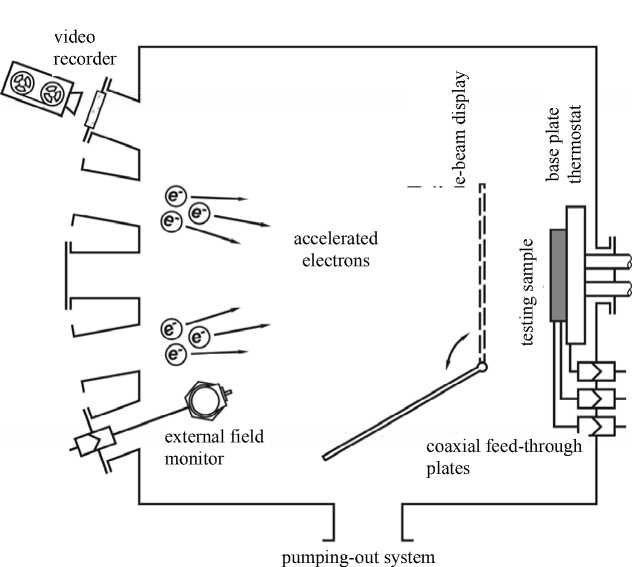
Fig. 1 Workstation scheme for tests
Рис. 1. Схема рабочего места испытаний
vacuum unit detachable connector cable assembly contacts
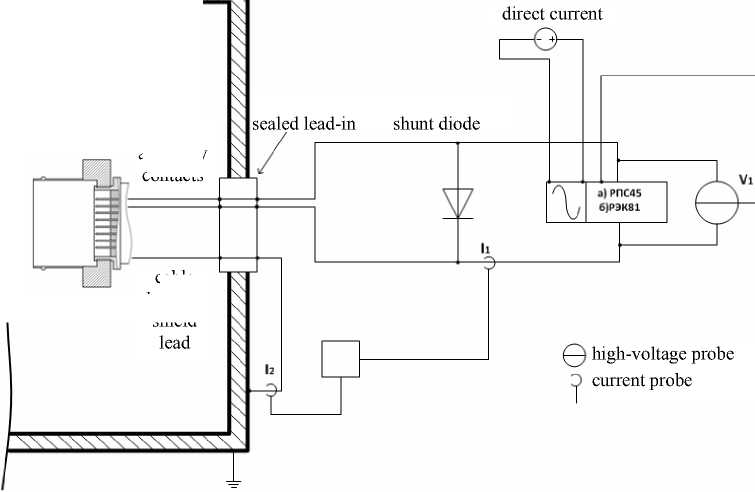
Fig. 2. The testing scheme for samples № 1 and 2
cable harness shield
oscillograph
Рис. 2. Схема проведения испытаний для образцов № 1 и 2
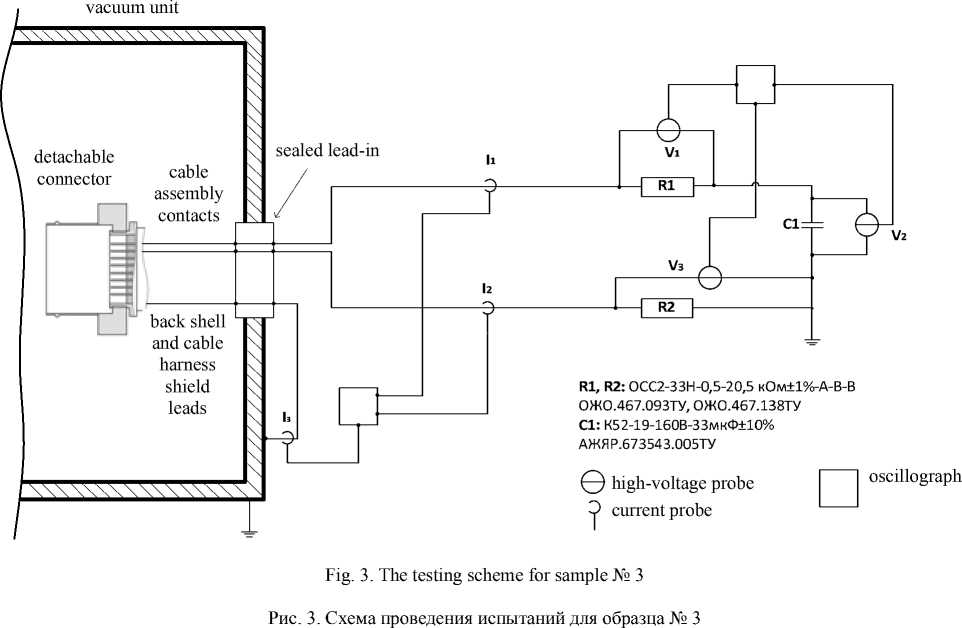
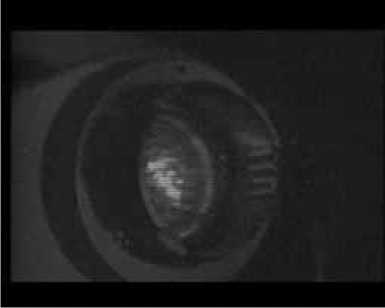
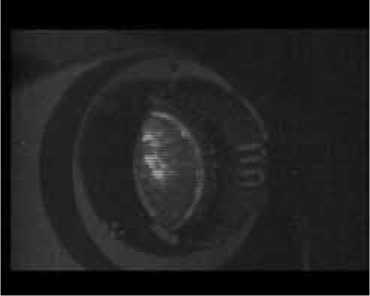
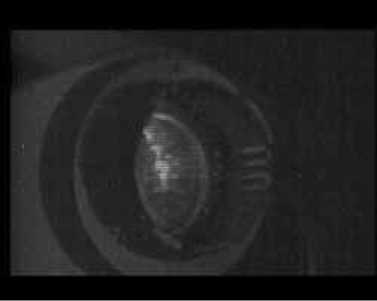
Fig. 4. Image of discharge pulses on the surface of connector isolation
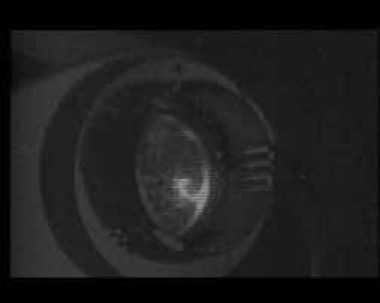
Рис. 4. Вид разрядов на поверхности изолятора разъема

а b
Fig. 5. Characteristic shapes of inducted pulses in samples electrical circuits: a – shapes of current pulses; b – shapes of voltage pulses
Рис. 5. Характерная форма индуцированных помеховых импульсов в цепях образцов: а – осциллограммы импульсов по напряжению; б – осциллограммы импульсов по току
Discharge pulses characteristics in circuits linked to the connector depend on the loads (board equipment elements and devices).
By imitation of technological circuits linking the detachable connector and the spacecraft power conditioning unit (fig. 3) the voltage values of interfering current pulses varied from 10 to 80 V and current value varied from 160 mA to 6.5 A. Pulse duration time was within the range from 300 ns to 1.1 µs. Based on the obtained characteristics interfering pulse energy values vary from 0.5 µJ to 0.57 mJ.
The obtained voltage values of interfered pulses in circuits of RPS45 relay winding were from 120 to 138 V and the current values were from 1.2 to 3 А. Cable harness pulses duration time was less than 1 µs. Pulse energy was no more than 0.4 mJ. Pulse voltage characteristics for REK81 relay were from 30 to 138 V and current ones were from 4.6 to 9 А. Pulse duration time was no more than 500 ns. Pulse energy was no more than 0.62 mJ. Distinctive pulse forms are shown on fig. 5.
During the relay commutation control mode (for both RPS45 and REK81) it was estimated that interfering pulses in circuits can induce interference in the normally opened relay contact. The shape and duration time of this interference correlate to the pulses detected in winding contacts. In this case directed pulse amplitude in normally opened contacts is not higher than 10 % of inducted pulse amplitude in the circuit of relay winding. During the test operation the impact of interfering pulses on the recorded values in normally closed contacts was not found.
It is necessary to point out that the shapes of inducted pulses in electrical circuits of two examined relay types are various. For RPS45 the pulses are splashes of positive polarity following by attenuation. For REK81 the directed impulse in winding circuits is a damped sinusoid. This characteristic may be caused by various relay physical parameters having an effect on the discharge current flow process. Nevertheless, the amplitude and the energy of the interfering pulse is virtually the same for both types.
It is arguable that the detected interference in normally opened contacts of two relay types is an electromagnetic pickup and the change arrangement of relay contacts (closing and opening) by the interfering pulses impact in circuits of the winding is not available.
During the test performance the impact of electron flux density on charge-discharge processes in cable harness was estimated. For this purpose an impact was conducted by electron beam density 0.1 nA/cm2 (by electron energy 70 keV). It is found that the change of this beam characteristic has an impact only on charge-discharge processes intensity. With increase of beam density the charge-discharge processes intensity grows. An impact on the maximum potential of connector surface isolation and interfering pulse characteristics in circuits of cable harness by various types of loads is not available.
The obtained results correspond to the “worst case” of the charging factors impact in the circuit of onboard equipment linked to the detachable connector. For the test a cable of length 500 mm (standard cable length varies from 2 to 5 m) was used. The increase of cable length can cause interference reduction.
Conclusion. The connector contact field isolation accumulates an electrostatic charge effectively by the impact of an electrojet current and its value is limited by charge processes on the isolation surface.
Charging processes on the connector contact field isolation induce interfering pulses in circuits of cable harness linked to the various types of loads which are appropriate to spacecraft onboard equipment. The maximum interfering pulse for the spacecraft power conditioning unit elements was 80 V (voltage value) and 6.5 А (current value). The pulse energy is 0.6 mJ by the duration time 1.1 µs.
By imitation of technological circuits of the spacecraft control unit two relay types (RPS45 and REK81) were used as loads. The maximum levels of interfering pulses in circuits of relay winding were 138 V (voltage value) and 3 A (current value) for RPS45 and 138 V (voltage value) and 9 A (current value) for REK81. By the pulse duration time 1 µs and 500 ns the energy was 0.4 mJ for RPS45 and 0.62 mJ for REK81.
The relay commutation control showed that interfering pulses in the circuit of the relay winding can induce pickups with the voltage amplitude from 7 to 25 V and with the duration time less than 1 µs on normally opened relay contacts. In this case changes of the contacts switching state of both types are not available.
The obtained results are of significant interest and can be used in spacecraft equipment designing in the sphere of interference immunity and proper functioning.
Список литературы Investigation of charge-discharge processes in the spacecraft detachable connector
- Максимов И. А., Кочура С. Г. Исследование влияния факторов космического пространства и техногенных факторов на космические аппараты, разработка методов и средств защиты: монография / Сиб. гос. аэрокосмич. ун-т. Красноярск, 2011. 182 с.
- ECSS-E-ST-20-06C. Космическое проектирование. Электризация космических аппаратов. Стандарт / Европейское космическое агентство. 2008. 120 c.
- Модель космоса. В 2 т. Т. 2. Воздействие космической среды на материалы и оборудование космических аппаратов / под ред. М. И. Панасюка, Л. С. Новикова. М.: КДУ, 2007. 1144 с.
- Наземные стендовые испытания космических аппаратов на стойкость к воздействию радиационной электризации / О. С. Графодатский [и др.] // Руководство для конструкторов / ЦНИИМаш, ГОНТИ-1. 1992. 157 с.
- NASA-HDBK-4002A. Mitigating in-space charging effects - a guideline. NASA, 2011. 181 p.

